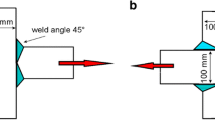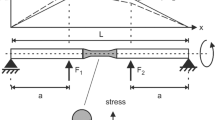Abstract
Large-scale fatigue testing of welded components is required under certain circumstances. These tests are expensive and time-consuming and hence need special care in their preparation and performance. This document is intended as a best practice guide for such tests. Aspects considered are model design and manufacture, preparation and performance of the test and evaluation of the results. Special measures needed for corrosion fatigue testing are also covered.
Similar content being viewed by others
References
Fatigue testing of welded components, Welding in the World, September–October 1991, vol. 29, No. 9/10, pp. 250–282.
Hobbacher A.: Fatigue design of welded joints and components, International Institute of Welding, Abington Publishing, Abington Hall, Cambridge, 1996.
Niemi E. (editor): Stress determination for fatigue analysis of welded components, International Institute of Welding, Abington Publishing, Abington Hall, Cambridge, 1995.
Niemi E., Fricke W., Maddox S.J.: Structural hot-spot stress approach to fatigue analysis of welded components — Designer’s guide, doc. IIW-1493-00 (ex-doc XIII-1819-00/XV-1090–01), (to be published).
Husset J. et al.: Fatigue crack growth monitoring using a crack front marking technique, Welding in the World, 1985, vol. 23 No. 11/12, pp. 276–283.
Lambert S. B. et al.: Simulation of fatigue behaviour of tubular joints using a pipe to plate specimen, Mat. Sc. Forum, 1986, Vol 8, pp. 215–224.
Gimperlein D.: S-N curve slope for welded structures, doc. IIW-1386-97 (ex-doc XIII-1697-97) Welding in the World, September–October 1998, vol. 41/, No. 5, pp. 399–406.
Lieurade H.P.: IIW Fatigue testing standards and effect of quality and weld improvement method, Proc. Int. Conference on “Performance of Dynamically Loaded Welded Structures”, WRC, New York, 1997, pp. 198–204.
Lu J. et al.: Study of residual welding stress using the step-by step hole drilling and X-ray diffraction method, doc. IIW-1170-92 (ex-doc X-1527-92/XIII-1598–93), Welding in the World, March–April 1994, vol. 33, No. 2, pp. 118–128.
Bignonnet A., Lieurade H.P.: Simulation of a marine environment, IIW doc. XIII-WG1-27–90, 1990.
Guidance for statistics — Fatigue tests analysis, IIW doc. XIII-WG1-107–03, 2003.
Marquis G., Mikkola T.: Analysis of welded structures with failed and non-failed welds based on maximum likelihood, doc. IIW-1511-00 (ex-doc XIII-1822–00), Welding in the World, January–February 2002, vol. 46, No. 1/2, pp. 15–22.
Code of practice for “Fatigue design and assessment of steel structures” BS 7608, 1993, BSI Standards, London.
Author information
Authors and Affiliations
Rights and permissions
About this article
Cite this article
Petershagen, H. IIW Guidance on Fatigue Testing of Large-Scale Welded Components. Weld World 48, 13–19 (2004). https://doi.org/10.1007/BF03263397
Published:
Issue Date:
DOI: https://doi.org/10.1007/BF03263397




